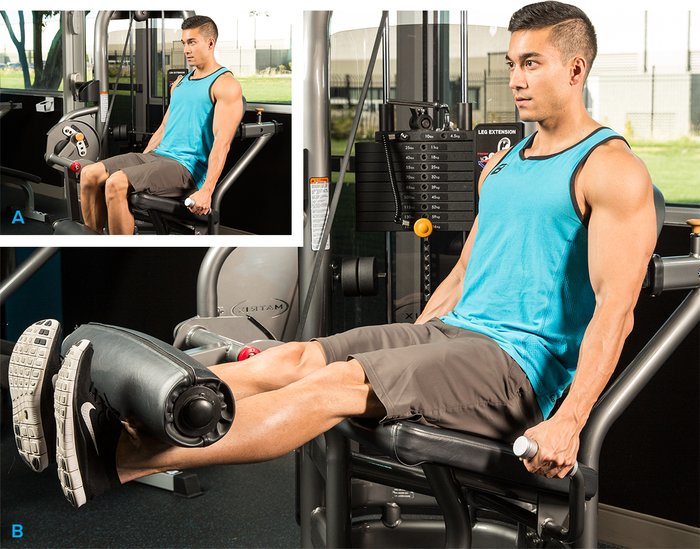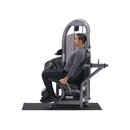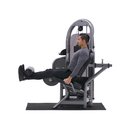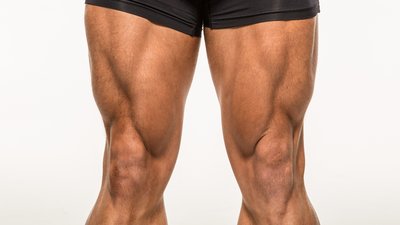If you're like most lifters, you either love or hate leg day, but those incredibly painful lower-body workouts are what separate the beach-muscle crowd from the serious lifters. You can't hide which camp you belong to; serious lifters (and even onlookers) can always tell.
Now, imagine turning up the intensity on what's already the most challenging workout of the week. That's what you'll be doing with this pre-exhaust leg routine. It's perfect to keep in your arsenal for when your leg training has plateaued, you're just looking to try something new, or you want a change of pace from heavy squats.
I can already see some folks running for cover. The rest of us will just happily limp out of the gym.
Show No Mercy
Most leg routines start with multijoint exercises like squats and lunges, because they recruit the greatest degree of muscle mass and allow you to lift the heaviest weights. After blitzing your thighs and glutes from a number of angles, you typically then finish them off with single-joint exercises to further fatigue the individual muscle groups.

Leg Extension
That strategy is reversed in a pre-exhaust workout. Here, you highly fatigue your quads—or hams or glutes—with an isolation move first, so that prime mover becomes the weak link in the multijoint exercise that follows. This technique makes just about every exercise that comes after your initial movement a whole lot harder!
For legs, that could mean starting your training session with leg extensions, which focus on just the quads, then doing squats, leg presses, and lunges. Because the quads are so highly fatigued by the time you start your multijoint exercises, and your hams and glutes are fresh, your set will end when your quads are completely fatigued rather than your posterior chain muscles.
This ensures that your quads will be worked to their limit—be the weak link, if you will—rather than the glutes or hamstrings.
The How and Why of Leg Pre-exhaust
Of course, switching the order of your exercises means you'll be notably stronger on the first movement—the one you normally do last in your workout—and significantly weaker when you do get to those multjoint exercises. This has potential benefits and drawbacks.
The upside: You'll be able to challenge your quads with loads higher than what they're normally exposed to. That means new growth! But it also means you need to curb your enthusiasm for piling on the weight and training in a lower rep range. With single-joint exercises, the added weight puts additional pressure on your knee joints, and training in a lower rep range can compound that pressure even further. I recommend keeping sets on all pre-exhaust movements to 8 reps or higher.

Barbell Squat
It also should go without saying that you'll have to lighten the load on your finishing exercises. Your regular squatting weights are going to feel much heavier. That early pump also means you'll have more trouble balancing free-weight loads done later in your workout, so you might consider do machine substitutes toward the end. There's nothing like trying to squat when your legs are fully pumped!
Once you figure out the sweet spot for weights and reps, though, you may find that a pre-exhaust routine actually reduces the stress placed on your joints, allowing you to perform exercises that may have been off-limits before. Athletes and lifters with lower-body ailments commonly use pre-exhaust so they can reach muscle failure on a demanding movement like squats with far less weight than if they had squatted first in their workout.
Pre-exhaust Quad Workout Notes
- Don't confuse a pre-exhaust with your warm-up. You'll still want to be warmed up and do a few very light sets before getting into your working sets.
- To make this into a hamstring-focused leg workout, perform leg curls instead of extensions. Alternately, perform cable pull-throughs or single-leg cable kick-backs for a glute-focused leg workout.
- To more completely fatigue the target muscle, add a couple more sets of the first exercise than you usually do. That means doing as many as 6 sets of leg extensions at the top of your workout.
- Continue your leg workout with a variety of multijoint exercises. As your legs become increasingly fatigued, it's more difficult to keep form and balance. Don't be afraid to go light on squats, use a squatter, or even use a Smith-machine rather than free weights. Since your legs are prefatigued, you won't be able to handle the same weights as you normally would.
- Choose weights that allow you to reach muscle failure by the target rep listed.



BodyFit
$6.99/month- 2,500+ expert-created single workouts
- 3,500+ how-to exercise videos
- Detailed workout instruction
- Step-by-step workout tips
- Training at gym or at home
- Access to Workout Plans
- Access to Bodyfit App
- Store Discounts
Already have a Bodybuilding.com account with BodyFit? Sign In

What comes with BodyFit?

- Instructional Videos
Don't risk doing a workout improperly! Avoid injury and keep your form in check with in-depth instructional videos.

- How-to Images
View our enormous library of workout photos and see exactly how each exercise should be done before you give it a shot.

- Step-by-Step Instructions
Quickly read through our step-by-step directions to ensure you're doing each workout correctly the first time, every time.


